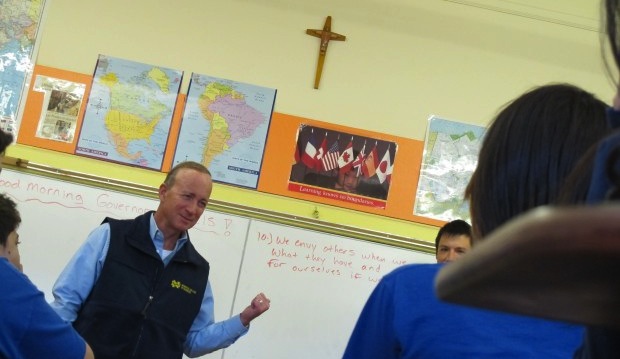A Decade After High Court Ruling, School Voucher Programs Growing & Spreading

Kyle Stokes / StateImpact Indiana
Governor Mitch Daniels addresses a class at Our Lady of Hungary Catholic School in South Bend, where enrollment has skyrocketed due to the state's private and parochial school voucher program, during a visit in December 2011.
Ten years ago Wednesday, as our colleagues at StateImpact Ohio note, the U.S. Supreme Court issued a landmark ruling in the case of Zelman v. Simmons-Harris, upholding a voucher program in Cleveland.
The result? 10 states and Washington, D.C. now offer public dollars to pay students’ private or parochial school tuition — and, over the objections of some public school groups, the programs are growing.
Eligibility for voucher dollars is often tied to a student’s family income. But many observers have termed Indiana’s new program the country’s most “expansive” because even some families who could pay on their own qualify for at least a partial scholarship.
More than 3,900 Indiana students received vouchers in 2011-12, the program’s inaugural year. This year, as The South Bend Tribune reports, more than 5,000 students have already signed up for the scholarships next year. (State law allows for as many as 15,000 to participate in the program this year; there’s no cap next year on voucher program enrollment.)
University of Arkansas professor Patrick Wolf studied voucher programs in Ohio, D.C. and New York leading up to SCOTUS’ Zelman ruling. He remembers the 2002 ruling as a milestone.
“Would the modestly positive test score results we uncovered in our study lead to more experiments with publicly-funded school voucher programs? Not if the Supreme Court ruled such programs unconstitutional,” Wolf blogs at School Choice Ohio.
In Zelman, the court ruled the state wasn’t directly funding religious schools, but giving voucher money to parents who spent it as they pleased.
But state dollars ending up in religious schools’ coffers still rubs some voucher opponents the wrong way. They also argue the program siphons off resources from public schools.
Indiana’s voucher program faces a lawsuit on those grounds. And other states’ programs face similar challenges — legal hurdles which Adam Emerson notes at Choice Words some states’ voucher initiatives are failing to clear.


